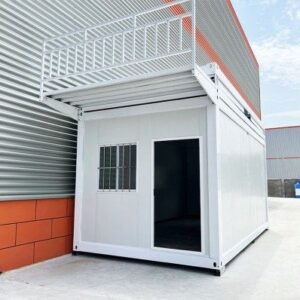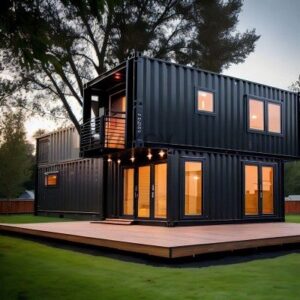Average Costs to Build a Shipping Container Home in 2025
When it comes to how much do shipping containers cost to build a house in 2025, the price can vary widely depending on design, location, and materials. On average, expect to spend between $150 to $250 per square foot for a fully finished shipping container home. This puts a standard 40-foot container home (roughly 320 square feet) in the range of $48,000 to $80,000, but this can climb quickly with higher-end finishes or complex modifications.
Used shipping containers prices in 2025 typically start around $3,000 to $6,000 per container, while new containers may cost closer to $5,000 to $9,000. Choosing used containers can help lower your base costs, but factor in potential repairs and cleaning. Shipping container modification expenses—like cutting windows, doors, and reinforcing walls—add another significant chunk, often $20,000 to $40,000 depending on complexity.
Shipping container home building costs in the U.S. also reflect site preparation, permits, and labor. Zoning permits for container homes vary by city but typically range from a few hundred to several thousand dollars, depending on local regulations. Labor costs for professional contractors experienced with container modifications can add 30-50% to your budget compared to traditional stick-built homes due to the specialized skills required.
Insulation is a must-have for container homes, with insulation costs for shipping containers ranging from $3,000 to $8,000. Proper insulation ensures energy efficiency and comfort, especially in cold or very hot climates common in parts of the U.S.
For multi-container house designs, expect higher costs due to the need for structural welding, connectors, and custom architectural elements. This can push prices into the $100 to $300 per square foot range depending on design complexity and finishes.
Overall, shipping container home costs in 2025 reflect a balance between container prices, modification fees, labor, and local permit requirements. Keep these key factors in mind to avoid unexpected expenses as you
Detailed Cost Breakdown of Shipping Container Home Building Costs
When you ask, how much does it cost to build a shipping container house, understanding the detailed cost breakdown is key. Container home building costs vary widely depending on materials, labor, modifications, and location. Here’s a clear look at the main factors influencing your budget.
Shipping Container Purchase
- Used shipping container prices 2025: A 40ft used container typically runs between $2,000 to $5,000, depending on condition and location.
- New shipping containers cost more—expect around $4,000 to $7,000 for a 40ft container, but they come with fewer issues like rust and structural wear.
- Buying multiple containers for multi-container house designs will naturally increase this base cost.
Modification and Construction Costs
- Shipping container modification expenses include cutting for doors and windows, reinforcing walls, and welding. This can add $10,000 to $20,000 or more depending on complexity.
- Interior framing and installation of utilities—plumbing, electrical, and HVAC—can run $15,000 to $30,000.
- Insulation costs for shipping containers vary by method: spray foam, rigid board, or blanket insulation can cost between $5,000 and $15,000 depending on size and climate requirements. Proper insulation is critical for energy savings and comfort (learn more about insulating container homes).
Permits and Zoning Fees
- Zoning permits and building fees are often overlooked but can add $2,000 to $7,000, depending on your local regulations.
- Some jurisdictions are still adapting to container homes, so checking local codes early is crucial to avoid fines and costly redesigns.
Interior Finishes and Systems
- Interior finishes like drywall, flooring, cabinets, and appliances typically range from $10,000 to $25,000 depending on your choices.
- Off-grid container home utilities, such as solar panels and water systems, add to costs but are optional upgrades. Expect an additional $5,000 to $15,000 if you want full off-grid capability (example solar container homes).
Labor Costs
- Labor for container house construction often accounts for 20-40% of your budget depending on your involvement. Skilled labor rates vary widely but budget for $15,000 to $40,000 for a typical 1,000-1,500 sq. ft. build.
Cost per Square Foot
- On average, building a shipping container home in the U.S. costs between $150 and $300 per square foot.
- This is competitive compared to traditional home builds and varies widely depending on customization and finishes.
Table
| Cost Category | Price Range (USD) |
|---|---|
| Used Shipping Containers | $2,000 – $5,000 per 40ft |
| New Shipping Containers | $4,000 – $7,000 per 40ft |
| Modifications and Welding | $10,000 – $20,000+ |
| Insulation | $5,000 – $15,000 |
| Permits and Zoning Fees | $2,000 – $7,000 |
| Interior Finishes and Systems | $10,000 – $25,000 |
| Off-grid Utilities (Optional) | $5,000 – $15,000 |
| Labor Costs | $15,000 – $40,000 |
| Average Cost per Square Foot | $150 – $300 |
Understanding these costs in detail helps you prepare a realistic budget and avoid surprises. If you’re curious about your specific project, check out our detailed guide on how much does a container house cost to build for
The Basics What Goes Into a Shipping Container Home Build
Building a shipping container home involves more than just stacking metal boxes. At its core, shipping container home building costs reflect a mix of materials, labor, and specialized modifications to turn industrial containers into comfortable living spaces.
Choosing the Right Container
Your project starts with selecting containers — either new or used shipping containers. New containers typically cost more but require less repair. Used containers are cheaper but might need extra work for rust, dents, or structural damage. The average price of a 40ft shipping container for a house ranges widely based on condition and location, so it’s crucial to source containers wisely.
Structural Modifications
Converting containers into livable quarters demands extensive modification—this is where many shipping container modification expenses come in. Cutting out windows, doors, and walls to open the space, reinforcing structural integrity, and installing roofing or insulation are common tasks. These steps require skilled labor and materials, impacting your overall budget.
Insulation and Climate Control
Shipping containers are steel boxes that get extremely hot or cold, making insulation costs for shipping containers a vital factor. Depending on your climate and desired comfort, you’ll need to invest in spray foam, rigid foam panels, or other eco-friendly insulation options to regulate temperature and improve energy efficiency.
Utilities and Permits
A fully functional container home requires hooking into or creating off-grid container home utilities such as plumbing, electrical, and HVAC systems. Plus, don’t forget about zoning permits for container homes and building approvals—these can vary by area and influence your timeline and budget. Research local codes early to avoid surprises.
Interior and Exterior Finishing
The final steps include drywall, flooring, painting, and exterior treatment. These finishes turn rugged containers into stylish, cozy homes, especially with multi-container house designs that offer more space and flexibility. Interior customization contributes notably to the cost of modifying shipping containers for living space but also adds real value.
Understanding these core components helps you grasp what drives shipping container home building costs and sets realistic expectations for your project. For a detailed look at pricing and design options, explore our guides on how much do container houses cost.
Prefab vs Custom Comparison for Shipping Container Home Building Costs
When deciding how much it costs to build a shipping container home, one of the biggest factors is whether you go prefab or custom. Both paths have distinct advantages and impact your budget differently—understanding these can help you plan better and avoid surprises.
Prefab Container Homes
Prefab container homes come pre-designed and partially or fully built by manufacturers. These models are often modular, meaning you can select layouts and finishes but stay within a set framework. Prefab container home kits usually include:
- Structural modifications done in a factory
- Basic insulation and interior walls
- Standard plumbing and wiring setups
- Exterior painting and weatherproofing
Cost benefits of prefab homes:
- Lower labor costs since much of the work is done off-site
- Faster construction timelines, reducing overhead and financing costs
- Predictable pricing with fewer unexpected expenses
- Easier to secure permits due to standardized plans
Typical costs for prefab container homes range from $40,000 to $120,000 for a 1-2 bedroom space, depending on size and finish level. For example, a basic prefab 40-foot container house can be on the lower end, while luxury prefab options with premium insulation and appliances are higher priced.
Check out options like these 40 foot container house kits if you want to explore prefab pricing and plans.
Custom Container Homes
Custom shipping container homes are built from scratch or heavily modified to fit specific needs and designs. This route offers complete freedom on layout, finishes, and features, but comes with higher complexity and cost.
Cost drivers in custom builds:
- Extensive shipping container modification expenses like cutting, welding, and structural reinforcements
- Custom insulation work which can be pricey depending on climate needs
- Unique plumbing and electrical systems tailored to your floor plan
- Architectural and engineering fees to meet local zoning permits for container homes
- Longer construction timelines with higher skilled-labor costs
A custom shipping container home can easily reach $150,000 or more, especially with multi-container house designs or off-grid utilities. You pay for flexibility and one-of-a-kind features, but it requires careful budgeting to handle hidden costs.
Cost Comparison Table
| Aspect | Prefab Container Home | Custom Container Home |
|---|---|---|
| Average Cost | $40,000 – $120,000 | $120,000 – $250,000+ |
| Construction Timeline | 3-6 months | 6-12 months |
| Labor Costs | Lower (factory-based work) | Higher (on-site skilled labor) |
| Design Flexibility | Limited to available models | High customization |
| Permit Process | Smoother (standard plans) | Complex (custom plans) |
| Modification Expenses | Minimal | High (cutting, welding, framing) |
| Insulation and Utilities | Basic to moderate | Custom tailored |
Which One Makes Sense for Shipping Container Modification Expenses
If you’re starting out and want to keep container home building costs predictable, prefab options save you money and time. They’re great if you want a smart, eco-friendly tiny container home without much fuss.
Custom builds work best if you need unique layouts or multi-container house designs that fit specific lifestyle needs, such as off-grid container home utilities or luxury touches. Just be ready to manage a bigger budget and a longer timeline.
For in-depth guidance on building either prefab or custom container homes, explore how to build a house using shipping containers. It covers step-by-step details to help you make the right choice.
Hidden Costs That Can Derail Your Shipping Container Home Budget
When planning your shipping container home build, it’s easy to focus on the obvious costs like containers, materials, and labor. However, many people overlook hidden expenses that can quickly blow up your budget if you’re not prepared.
Permits and Zoning Fees
One of the biggest surprises is the cost of zoning permits and fees. Depending on your location, local building codes or HOA rules may require special approvals for container homes. This process can include:
- Application fees
- Impact assessments
- Inspections
In some areas, meeting these requirements can be time-consuming and costly, impacting both your timeline and wallet.
Modifications and Insulation Costs
Converting a shipping container isn’t just about cutting doors and windows. Modifications for plumbing, electrical systems, and insulation add up quickly. For example:
- Insulation costs are often higher than traditional homes because steel containers conduct heat and cold intensely.
- Specialized insulation like spray foam or rigid panels is necessary to make the home livable in most U.S. climates.
- Additional expenses come from welding, framing, and reinforcing container walls to meet safety standards.
Site Preparation and Utilities
Your container home needs a solid foundation and access to utilities, but site work often gets underestimated. Think about:
- Grading and leveling your land
- Foundation costs specific to containers (like piers or slabs)
- Hooking up water, electricity, and sewage
- Adding off-grid systems if you want solar power or septic tanks
All these influence your shipping container modification expenses and overall budget.
Shipping and Delivery
Whether you’re buying new or used containers, delivery fees can be steep depending on your site’s location. Transporting containers from ports or suppliers often requires heavy equipment and permits for oversized loads, which adds to your cost.
Unexpected Labor and Materials
Lastly, expect some unexpected expenses for materials that change mid-build or additional labor hours due to unforeseen challenges like:
- Difficulty cutting or welding thick steel walls
- Weather delays
- Upgrading materials for better durability or sustainability
Being aware of these hidden costs will help you plan a realistic shipping container house construction timeline and budget without surprises.
Cost Saving Strategies Build Smart with Yichen
When it comes to container home building costs, saving money without cutting corners is key. Yichen’s approach focuses on smart planning and smart spending to get you more bang for your buck.
Choose Used Shipping Containers Wisely
Used shipping container prices 2025 vary a lot, but going for gently used containers can significantly cut your initial costs. Inspect them well for damage or rust—this avoids costly repairs later.
Opt for Prefab Container Home Kits
Prefab kits simplify modification expenses. Yichen recommends prefab models for those on a tighter budget since they come partly built and tested, reducing labor costs and time spent on zoning permits for container homes. Prefabs also minimize waste, keeping your build more eco-friendly.
Focus on Efficient Insulation
Insulation costs for shipping containers can add up fast if you’re not careful. Using advanced spray foam or insulated panels strategically—only where you need them the most—keeps energy bills down without unnecessary expense.
Plan Multi-container House Designs
Stacking or linking multiple containers adds space and functionality but planning smart helps avoid structural overengineering. Yichen suggests designing with modular layouts that cut down on extra welding and framing work.
Handle Permits and Fees Early
Hidden costs of building with shipping containers often come from zoning and permit delays. Get your shipping container house permits and fees cost sorted upfront to avoid last-minute fines or redesign costs.
Go Off-Grid if Possible
While initial setup for off-grid container home utilities can seem high, in the long run, it saves on utility bills and adds value. Yichen advises incorporating solar panels or rainwater collection from the start to spread these costs over time.
DIY When You Can
Labor costs to build a shipping container house eat up a big part of your budget. Taking on simple jobs yourself like painting, cleaning, or interior finishing lowers your overall spend while keeping quality under control.
By blending these strategies, Yichen helps keep your **shipping container modification expenses
Is a Container Home Right for You Real Talk and Next Steps
Building a shipping container home isn’t for everyone, but it can be a great fit depending on your lifestyle, budget, and location. Before jumping in, think carefully about your needs and challenges to see if this option matches what you want.
Who Benefits Most from Container Home Building
- People seeking affordable, eco-friendly housing. Shipping container homes often have a lower environmental impact, especially if you choose used containers and sustainable insulation.
- Those with limited land or looking for a small footprint home. Because shipping containers have a fixed size, they’re perfect for tight lots or tiny home enthusiasts.
- DIYers and people open to prefab options. If you don’t mind some hands-on work or want to save by choosing prefab container home kits, this approach can be cost-effective.
- Owners eyeing off-grid utilities or alternative living. Containers adapt well for solar, rainwater collection, and other off-grid setups, which may lower long-term utility expenses.
Challenges and Considerations for Container Home Owners
- Zoning and permits can be tricky. Many local building codes weren’t designed with container homes in mind. Always check your area’s rules to avoid delays or extra fees.
- Insulation and climate impact cost and comfort. Shipping containers are metal boxes that get hot and cold fast, so insulation expenses can add up, especially in places with extreme weather.
- Design limitations. The narrow width (about 8 feet) of containers means custom layouts require multiple containers or creative modifications, which raise costs.
- Hidden costs like foundation, transport, and professional labor. These often catch first-time builders off guard.
Next Steps If You’re Considering a Container Home
- Research local building codes and zoning permits to understand what’s allowed and required.
- Decide between prefab container homes or custom builds. Prefab kits offer convenience and predictability, while custom builds allow more design freedom but need more planning and budget.
- Get quotes on used vs new shipping container prices in 2025 to see what fits your budget.
- Plan your insulation and utility needs early, factoring in climate and off-grid options if relevant.
- Consult experienced builders or architects who specialize in shipping container modification expenses, so you avoid costly design flaws.
- Consider sustainable housing budget tips like repurposing materials or phased building



